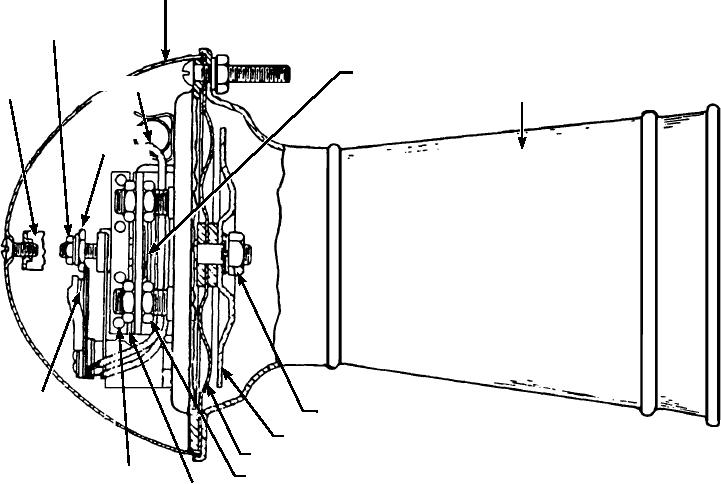
BACK SHELL
ADJUSTING
LOCK NUT
FIELD COIL
BACK SHELL
BRACKET
PROJECTOR
ADJUSTING
NUT
CONTACT
DISC LOCK
POINTS
DISC
ASf06087
DIAPHRAGM
LAMINATED
AIR GAP ADJUSTING NUT
ARMATURE
AIR
GAP
Figure 6-87.--Electrical vibrator-type horn.
of 11 volts is required for the 12-volt horn, and a
magnetic field to attract the armature of the coil to the
minimum of 22 volts is required for the 24-volt horn.
winding core. The armature is mounted to the horn
diaphragm so that movement of the armature causes a
Tone and volume adjustments are made by loosen-
distortion of the diaphragm. The armature movement
ing the adjusting locknut and turning the adjusting nut.
also operates the horn contact points that break the
This very sensitive adjustment controls the current
circuit.
consumed by the horn. Increasing the current increases
the volume; however, too much current will make the
When the contact points open, the magnetic field of
horn sputter, and may lock the diaphragm.
the winding collapses, and the armature returns to its
normal position as the distortion of the diaphragm is
Dual Horns
relieved.
When the contacts are closed again, a new surge of
In dual horns, one horn having a low pitch is
current induces magnetism in the coil and starts a
blended with another horn having a high pitch. These
second movement of the diaphragm. This cycle is
horns, although operated electrically, produce a sound
repeated rapidly. Vibrations of the diaphragm within an
closely resembling that of an air horn. The sound
air column produce the note of the horn.
frequency of the low-pitch horn is controlled by a long
air column, and that of the high-pitch horn by a short air
Adjustment
column. The air column is formed by the projector and
by a spiral passage cast into the base of the horn.
Before making any adjustment, ensure that the horn
Most horns draw enough current to necessitate
is properly grounded and there is correct voltage at the
having a relay in the circuit. A horn circuit that has a
horn. To obtain a good sound from a horn, a minimum
6-71

